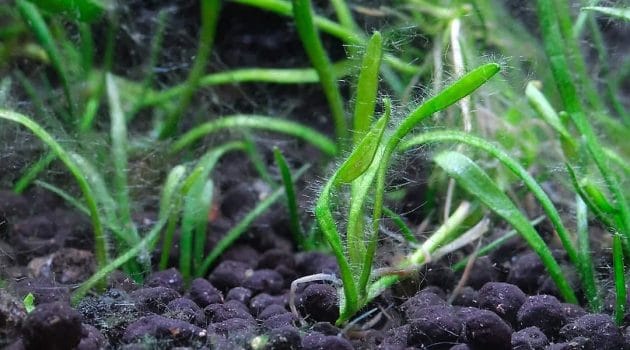Fuzz algae are another hairy green algae that often attack the aquarium. Like their name, this algae has a green color and is filamentous and short in size.
They usually grow on decorations, aquatic plants, and aquarium glass. If you let them develop in the tank, these algae will propagate themselves and form a thick coat that looks fuzzy-looking from the outside.
Many aquarists sometimes confuse it with green hair algae; they are almost similar in appearance but really different. Even some aquarium hobbyists think the fuzz algae is the early growth stage of the hair algae.
The difference between fuzz and hair algae is that fuzz algae grow as individual filaments, while the other one grows to form a heavy coat on the objects, where their filaments grow more densely than those.

Is Fuzz Algae Bad?
A healthy planted aquarium usually has some kind of algae type in there, while the problem is the quantities of their population.
If your aquascape tank has a small population of fuzz algae, it can still be called “normal,” but if they start to overgrow and get out of hand, you should begin to fight with them.
Most aquarists battle with them for the first few months when the tank maturity is still imbalanced; some succeed in treating their aquarium, but others fail, and the fuzz algae overtake their tank. Some tank keepers feel stressed because of these pests and decide to rebuild their tanks from the start.
The fuzz algae will be worse if left untreated. They grow quickly and are difficult to get rid of once they are established in the aquarium. Keep reading this article; our guides will help you beat these algae.
Is The Fuzz Algae Harm For Fish And Other Aquarium Live Stocks?
Nope. The fuzz algae are not harmful to fish and other live stocks in your tank as long as you can handle their population. For some fish species, this probably becomes additional food, which is good for their metabolism and growth rate.
Common Causes Of Fuzz Algae
There are several reasons that cause the fuzz algae to bloom in your tank, so if you know more profoundly about it, the chances of preventing the invasion of this algae are bigger. It will also help you beat them up if your tank is affected by the fuzz algae.
You are visiting the right page, and luckily, our article offers the solutions to remove the fuzz algae if they grow uncontrolled.
When you observe your tank and see fuzz algae sticking on the objects, that means there is an imbalance of necessary elements in the ecological aquarium system.

The fuzz algae commonly strike young and older planted tanks. They can be categorized as not harmful algae species like green dust algae.
Unlike other algae types, you can leave a small population of them in your tank as long as you keep these algae under control. They are probably fine and may become a delicious snack for your algae eaters, but do not let them take over your entire aquarium.
Young Tank
Fuzz algae often appear inside new setup tanks because it has not reached full maturity age yet, causing imbalanced conditions that usually run for the first few weeks.
This transition commonly takes around 4-8 weeks; at this point, we recommend not adding any extra aquatic plants before this part is complete. Adding more plants can sometimes lead to other problems, such as the population explosion of ramshorn snails due to being carried in unsafe newly added plants.
Instead, putting some extra algae eaters, such as SAE fish or cherry shrimps, can reduce the algae growth.
Older Tank
In the older tanks, the presence of this algae is frequently triggered by imbalances of the macronutrients. As stated before, if only there is a small population of fuzz algae in your fish tank, it is still quite normal, and there is no reason for concern.
Deficiencies Of Light
Leaves and stem plants that are not fully exposed to enough light are usually susceptible to being overgrown with fuzz algae.
The affected aquarium plants probably suffer deficiency macronutrient problems. Even in the worst conditions, they might leak the nutrients absorbed back into the water, which is caused by these algae.
Insufficient CO2
Low or fluctuating CO2 dissolved in the water is a common problem that often leads most algae types to arise in the aquarium.
Fluctuation Carbon dioxide happens because the spread of CO2 levels is uneven. It probably occurred because of one or more things; for example, the CO2 Injector is not running correctly.
The CO2 levels should reach the desired level by the plants when the light from the aquarium LED. It aims to get an optimal result when photosynthesis is in progress.
How To Control Fuzz Algae In The Aquarium
We will tell you about two simple methods to control this issue in your aquascape tank.
Controlling Fuzz Algae With Algae Eaters
Adding some fuzz algae eaters into your tank can decrease their growth level naturally. There are some kinds of fish, shrimp, and snails that are really useful to clean them. Besides, they also offer spectacular shows when doing their job.
You have nothing left to do when you keep a couple of algae-cleaner species and let them work properly.

Before deciding what kind of fuzz algae clean-up crew to use, make sure they are suitable for your existing aquarium population.
Remember to perform a quarantine first before you put them into the tank; it is necessary to prevent unwanted things. They may carry any sickness or even be contaminated by some fungus or bacteria.
According to our experience and information from other aquarists, Amano shrimps are proof of effectively wiping up the fuzz algae. So, if you have enjoyed adding crustacean species, they are a good option.
If you prefer fish species, bristlenose pleco, Siamese algae eaters, otocinclus, and black mollies can help you to deal with these algae well. But zebra nerite snails might be a good option if you want a calmer and more peaceful algae remover.
Due to the shrimp size, which is relatively small, they may get siphoned by the aquarium’s filter, so be careful with that. Some fish species may look at the tiny shrimps as a delicious snack, so ensure the fish species that you are kept not harmful to them.
If you choose the right fuzz algae clean-up crews that are compatible with your tank population, the algae will be easy to control in no time.
Ensure Your Aquarium Is Always Clean
Keeping your tank clean is a great key to staying away from the fuzz algae invasion. Doing a regular water change can make the water parameters stable. Remove all leftover food, fish feces, and other organic waste using aquarium siphon tools.
Keep in mind, never overfeed your fish; it makes your aquarium look dirty and probably becomes toxic for all tank creatures.
If only a small amount of fuzz algae appears, you can use a wipe to remove them. But, if you sense the invasion is severe, you have to consult with an aquarium expert; they will suggest the best way you have to do it.
How To Get Rid Of Fuzz Algae From Your Aquarium
In order to eliminate fuzz algae, you can choose one or combine a few strategies below, depending on the outbreak level. So, you should understand the scale of the algae that is invading your tank.
Cut Down The Fuzz Algae Manually
A simple way to wipe them up before trying other advanced methods is by manually scrubbing the algae with an aquarium algae scraper or toothbrush. Keep in mind that it’s the best first step to temporarily cut down the algae population, not eliminating them entirely at once.
However, the fuzz algae will return in a couple of days or weeks, but it’s a safer method than using algaecides that probably kill your aquarium populations, although it can remove the algae population quickly.
Add More Algae Cleaner Crew
Keeping a lot of algae eaters can wipe up fuzz algae completely. Research to find what kind of algae eaters are compatible with your tank and how many individual cleaning members you need. The more algae-eating species you keep, the cleaner your aquarium will be.
Reduce their food intake to push them to consume more algae in the aquarium to get good results. If you have other specimens or fish populations in your tank, do not overfeed them, and make sure the algae eaters do not steal their food.
After the algae are gone, take out the algae cleaner or minimize their number. It aims to prevent the accumulation of organic waste that they produce so the tank ecosystem stays balanced.
Balancing The Nutrient Level
Macronutrients are one of the critical elements that are essential for aquatic plants to continue their life. The lower or higher level of NPK can usually drive the fuzz algae to spread.
So, if you do not want to use the second method above, in order to keep your tank clean without too much waste, balancing the nutrient level in the water is one of the good choices to try. The first step that you should take is to check the water parameters using a test kit. This aims to find out the imbalanced elements in the water.
When the results notice the nutrient level is too low or too high, you can find a proper way to adjust it again quickly.
Fuzz algae commonly thrive when the nutrient level is higher; the simple method to bring it down is planting other plants or doing a water change.
If macronutrients in your aquarium are too low, drop a couple of doses of aquarium fertilizers. It will instantly enhance the level of dissolved substances required by plants.
You can follow this formula as a reference to set up the nutrient level in your tank:
- Nitrate (NO3) = 10-25 mg/l
- Phosphate (PO4) = 0.1-1 mg/l
- Potassium (K) = 5-10 mg/l
- Magnesium (Mg) = >10 mg/l
Keep CO2 Stable
Lack of CO2 is the other reason for fuzz algae invasion in the aquarium. To solve this problem, inject carbon dioxide into your tank if you do not install it yet.
But, if you were installing it, raise the CO2 content in your tank to a specific number. Raise it little by little from one day to the next day. The sudden addition of a large amount of CO2 content can harm other specimens, such as fish or shrimps, so do it gradually.
We suggest keeping the dissolved CO2 in the water at approximately 20-30 mg/l. You can use a CO2 checker to monitor it easily.
Water Changes Regularly
Weekly water changes may keep your tank clean and preserve your aquarium in stable conditions that are loved by the tank populations.
This also can prevent the fungus, bacteria, and any types of invasive algae from developing, including this fuzz algae.
Every tank requires a different percentage of water change depending on its condition. So check your aquarium condition first; after that, you will learn what kind of water change requirements you should follow.
Be careful when siphoning or filling up the water; ensure it’s not making your tank population dangerous.
Use Liquid Carbon
In our experience, spraying the fuzz algae with liquid carbon directly effectively removes them from the aquarium. Use the plastic syringe, get a few doses of this liquid (we usually use 3-5 ml doses per day), and inject straight into the algae.
Depending on the conditions, you should do this for a couple of days to get the result, normally around 5-7 days or more. This liquid carbon is relatively cheap and easy to find; you can buy it at a local aquarium shop or online.
Use Algae Remover Products For Aquarium Usage
Many aquarium brand products offer safe chemical algae removers for aquarium inhabitants at affordable prices and are easy to find at local stores or online marketplaces.

These products are enough to kill fuzz algae in the aquarium without taking much time and effort. Some popular stuff like Azoo Algae Away, API Algaefix, Microbe-Lift Algaway, Tetra Algae Control, and Fritz Aquatics Algae Clean Out are usually used by many aquarists to control algae issues in their tanks.
Read the instructions on the product label first before using it. Excessive use of the cure might result in undesirable effects on your tank. Avoid this bad practice, although some products are labeled as secure for fish tanks.
Raising The Light Intensity
The light intensity, spectrum, and period may become another problem stimulating fuzz algae bloom. If you sense the light is too dim, you can change the aquarium LED with another lighter one. But you can instantly increase the light intensity if you use a bright LED tank.
In other cases, combining the higher light intensity and higher macronutrient level (NPK) that aquatic plants cannot absorb well can also drive the fuzz algae to invade.
To treat it, do a blackout for a few days until the fuzz algae level drops significantly. After that, add a few algae eaters to remove the remains and enhance the CO2 level. It makes your plants happy again.
Fix Your Water Circulation
You tried all the methods above, but the algae are still not gone. The water circulation might cause it. Generally, it is an issue in bigger aquariums and tank setups with weaker filter flow.
It makes fresh water and CO2 unable to reach every corner of the tank. By creating a dead spot where its favorite area to fuzz algae thrive.
Fix the filter flow or add a small powerhead to boost water flow. It helps the water actively run into the tank’s entire space, benefiting any plants.
Use Distilled Water
A small thing often forgotten is the utilization of water types when performing a water change. Many new aquarium keepers use tap water when doing that. Much tap water typically contains heavy metals and phosphate that fuel the growth of fuzz algae.
When changing the tank water, use the RODI water or distilled water to solve this problem. Many small stores or supermarkets provide bottles filled before or offer to refill RO water service; you just bring your reusable jug.
You can also produce your own distilled water in your home by purchasing a simple RO water system specifically for aquarium usage.
Kill Fuzz Algae With Algae Control Products
We do not advise using conventional algaecides or hydrogen peroxide to eliminate the fuzz algae in the aquarium. This product might work to remove algae in your tank. But it also probably kills your aquatic plants because it contains some harsh chemicals.
This product also cannot control algae growth for the long term; it just solves the problem for the time being. For the tutorial, you can see our article here.







